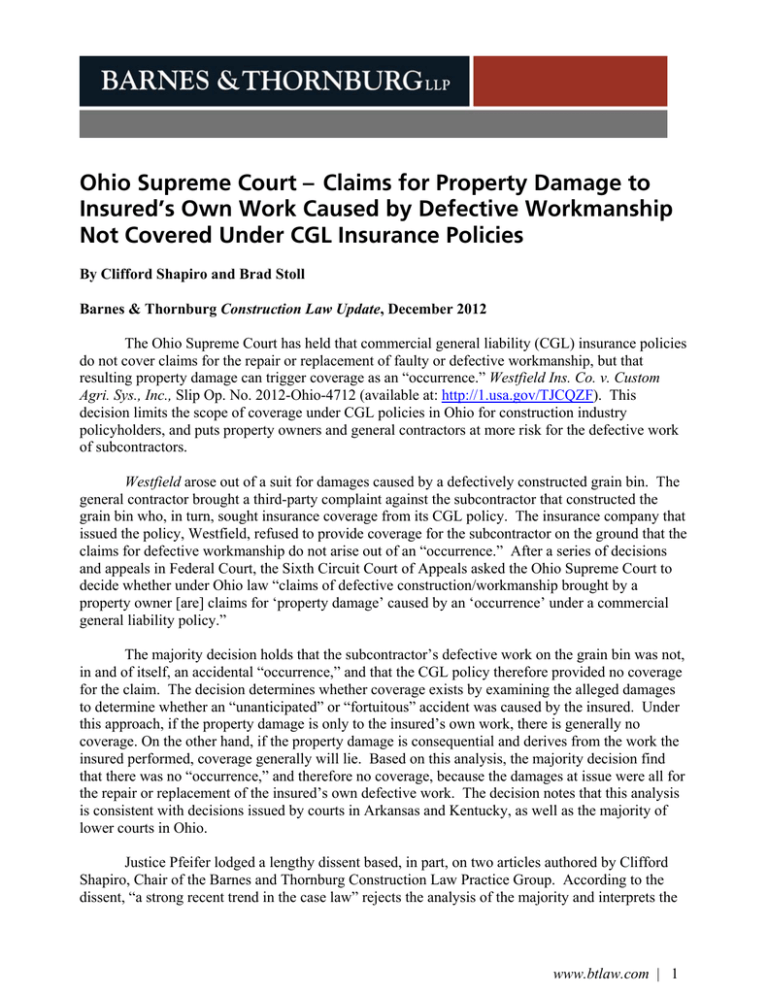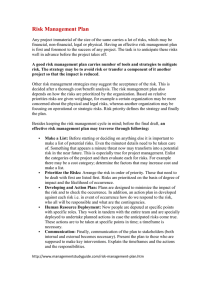
Ohio Supreme Court – Claims for Property Damage to
Insured’s Own Work Caused by Defective Workmanship
Not Covered Under CGL Insurance Policies
By Clifford Shapiro and Brad Stoll
Barnes & Thornburg Construction Law Update, December 2012
The Ohio Supreme Court has held that commercial general liability (CGL) insurance policies
do not cover claims for the repair or replacement of faulty or defective workmanship, but that
resulting property damage can trigger coverage as an “occurrence.” Westfield Ins. Co. v. Custom
Agri. Sys., Inc., Slip Op. No. 2012-Ohio-4712 (available at: http://1.usa.gov/TJCQZF). This
decision limits the scope of coverage under CGL policies in Ohio for construction industry
policyholders, and puts property owners and general contractors at more risk for the defective work
of subcontractors.
Westfield arose out of a suit for damages caused by a defectively constructed grain bin. The
general contractor brought a third-party complaint against the subcontractor that constructed the
grain bin who, in turn, sought insurance coverage from its CGL policy. The insurance company that
issued the policy, Westfield, refused to provide coverage for the subcontractor on the ground that the
claims for defective workmanship do not arise out of an “occurrence.” After a series of decisions
and appeals in Federal Court, the Sixth Circuit Court of Appeals asked the Ohio Supreme Court to
decide whether under Ohio law “claims of defective construction/workmanship brought by a
property owner [are] claims for ‘property damage’ caused by an ‘occurrence’ under a commercial
general liability policy.”
The majority decision holds that the subcontractor’s defective work on the grain bin was not,
in and of itself, an accidental “occurrence,” and that the CGL policy therefore provided no coverage
for the claim. The decision determines whether coverage exists by examining the alleged damages
to determine whether an “unanticipated” or “fortuitous” accident was caused by the insured. Under
this approach, if the property damage is only to the insured’s own work, there is generally no
coverage. On the other hand, if the property damage is consequential and derives from the work the
insured performed, coverage generally will lie. Based on this analysis, the majority decision find
that there was no “occurrence,” and therefore no coverage, because the damages at issue were all for
the repair or replacement of the insured’s own defective work. The decision notes that this analysis
is consistent with decisions issued by courts in Arkansas and Kentucky, as well as the majority of
lower courts in Ohio.
Justice Pfeifer lodged a lengthy dissent based, in part, on two articles authored by Clifford
Shapiro, Chair of the Barnes and Thornburg Construction Law Practice Group. According to the
dissent, “a strong recent trend in the case law” rejects the analysis of the majority and interprets the
www.btlaw.com | 1
term “occurrence” to encompass unanticipated property damage resulting from poor workmanship.
These other cases recognize that focusing on the type of damage resulting from faulty construction
do not truly address the issue of whether there has been an “occurrence.” This is because the CGL
policy includes numerous construction-specific exclusions that are intended to define the scope of
the coverage for construction defect claims. As such, an analysis of the “occurrence” issue that
focuses on the alleged damages “simultaneously fails to evaluate the policy as a whole and collapses
what should be a separate and specific analysis of the policy exclusions into the coverage grant
analysis of the term ‘occurrence.’”
According to the dissent, the better-reasoned Ohio appellate cases recognize that a CGL
policy is not the equivalent of a performance bond but also recognize that the rationale for that
proposition is not that the allegations of negligent construction or design practices do not fall within
the broad coverage for property damage caused by an occurrence, but that the damages resulting
from such practices are usually excluded from coverage by the standard exclusions found in such
policies. The dissent concludes: “The majority in this case makes an overbroad generalization
about CGL policies in Ohio. Answering a question it should not even be answering, the majority
misinterprets the contract and misapplies Ohio law, leaving us on the wrong side of the divide of
states that have considered this question.”
For more information about this topic and the issues in this article, please contact Clifford
Shapiro, chair of the Construction Law Department, in our Chicago office at (312) 214-4836 or
clifford.shapiro@btlaw.com and Brad Stoll at (614) 628-1416 or brad.stoll@btlaw.com.
Visit us online at www.btlaw.com.
© 2012 Barnes & Thornburg LLP. All Rights Reserved. This page, and all information on it, is proprietary and the
property of Barnes & Thornburg LLP. It may not be reproduced, in any form, without the express written consent of
Barnes & Thornburg.
This Barnes & Thornburg LLP publication should not be construed as legal advice or legal opinion on any specific facts
or circumstances. The contents are intended for general informational purposes only, and you are urged to consult your
own lawyer on any specific legal questions you may have concerning your situation.
www.btlaw.com | 2



